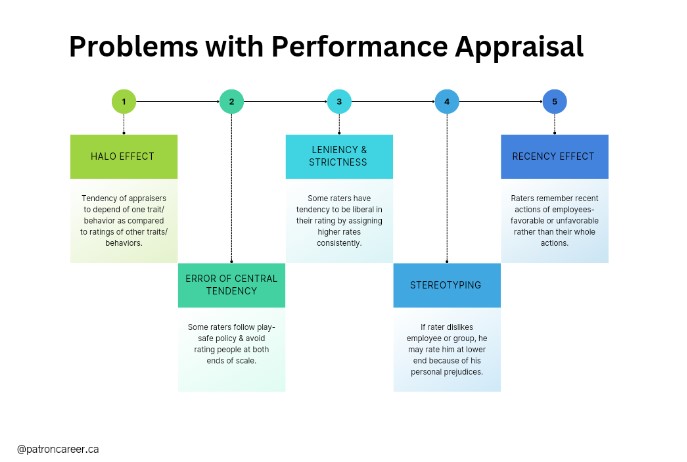
Performance Appraisal Guide
07 November, 2022
Patron Career Staffing firmly believes in adopting a tailored approach to meet temporary and permanent recruitment needs. We safeguard the interest of our clients by finding such workers who are knowledgeable and reliable.
About UsNeed help? Make a Call
32 Dundas Street East Unit A, L5A1W2

To gauge employee performance, productivity and engagement, companies use performance appraisal systems in the workplace. The benefits attached to creating and implementing an effective performance program are in abundance. Whether it is fruitful evaluation and responsive feedback on performance or aid to employee development, the year-end program is highly awaited by employees and workmen.
In this blog, we share and highlight the primary steps that organizations must take to create an efficient performance appraisal system and reap wondrous benefits from the same.
Following through with an appraisal system may work wonders to extract the potential of employees in the workplace. The systematic evaluation of an individual about his performance on the job and his potential for development is known as performance appraisal. It is identified as a managerial process in which employees' job performance is measured to a few predetermined criteria such as projects, and job responsibilities on which employee has worked and has contributed to the organization. It is also known as an ANNUAL REVIEW or PERFORMANCE REVIEW.

Though the following steps are recommended when preparing a performance appraisal system for your organization, perhaps you may contrive and add necessary steps as per your company's requirements.

1. Set clear appraisal goals
The very first step of the performance appraisal process is to establish performance standards and objectives. Performance standards must be necessarily instituted to comprehend what the company is seeking to achieve through the implementation of the stated program. It works in unison with the vision and mission of the company. Job descriptions, evaluation forms, questionnaires, and training manuals are some ways to establish performance standards.
Managers should strive to structure performance appraisals to be free from prejudices and personal biases. It has to align with the company's strategic goals and core values. Set out what your company expects out of an employee and what exactly 'efficient performance' means for you. Thus, goal setting will eventually help you in honestly scrutinizing the engagement and competency of employees on a year-round basis.
2. Establish expectations
Once your performance standards are laid down, you need to configure and communicate such expectations to your workforce. You have to let them know what's in store for them. Leaders don't let their employees feel disheartened and confused, so bear in mind to communicate minimum standards to retain the job or seek promotions and benefits.
3. Select your appraiser
Next, you need to decide who is eligible to conduct a performance appraisal. This is one of the most important decision company needs to make because many times crucial decisions are taken based on the score or rating given by the appraiser, like the development of employees in the organization, or the firing of unproductive employees. Inequities by appraising managers tend to forestall and discourage the usage of the appraisal system.
An appraiser's psychological, and social background such as values, beliefs, thoughts, ethical groups, etc. influence his or her perception of the appraisee. We call this 'perceptual set' and like it or not, it impacts the performance ratings. Likewise, companies may choose:
Related: A COMPLETE GUIDE TO PERFORMANCE APPRAISALS
4. Measure and compare performance criteria
Tick-boxing all aspects of performance appraisal is incomplete without having it expressed and evaluated in quantifiable terms- quality, numeric, ratings, grades, cost, timeliness, etc. But qualitative elements of employee performance- leadership skills, communication, customer service, and motivation to work is relatively difficult to define and measure.
During this stage, employees' actual performance is compared with the expected and predetermined performance standards on basis of the availability of information and resources- oral and written reports, statistical data, and personal observation.
While evaluating current performance, the appraisee's previous performance ratings may influence the mind-set of the appraiser. Also according to the recency effect, the appraiser may remember recent actions and deeds of the appraisee instead of the whole performance.
5. Feedback and discussion
Communicating the results of the appraisal to the employees is of utmost importance and it is regarded as one of the most challenging tasks appraisers have to perform. Even if the results are negative, managers must discuss them with the employee so there's always room for improvement. With proper feedback on the employee's strengths and weaknesses, they will be motivated to improve and produce desired results in the future.
6. Institute corrective action
For those employees who failed to be at par with the established standard, companies need to discuss the problems along with possible solutions to avoid future errors and mistakes. You may offer some type of training and development, coaching, or counseling sessions to improve their future performance. Build a performance improvement plan as a remedy to remove deviations and hindrances in the workplace.
A happy, engaged workforce will bring pride to your company, and to ensure this you need the right kind of performance appraisal system that eliminates manager bias and other biases.
